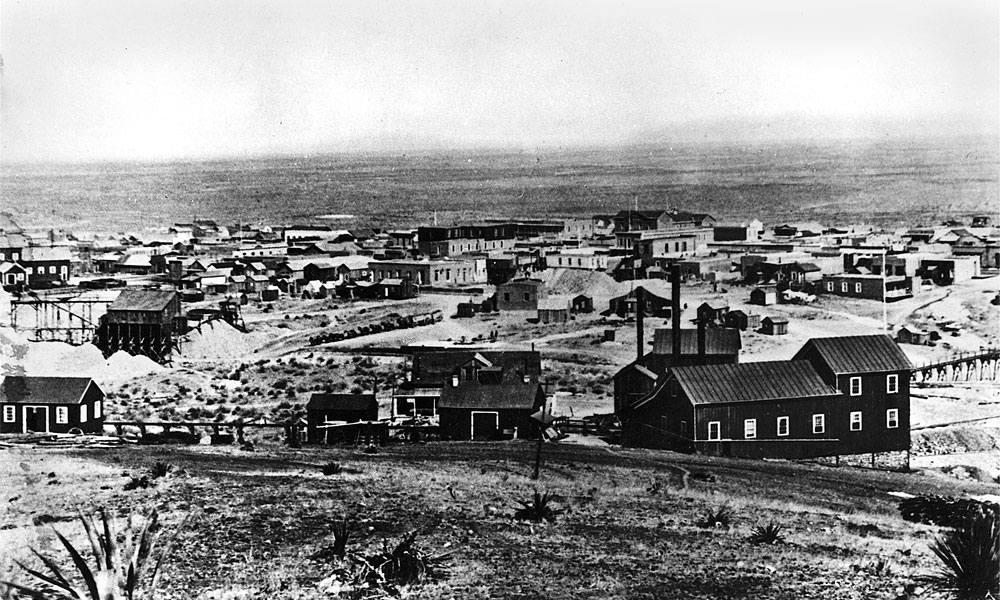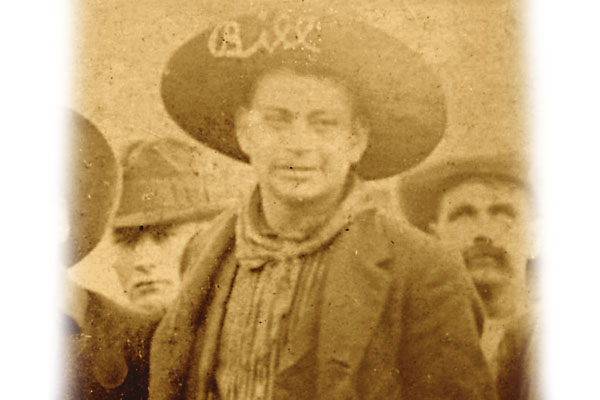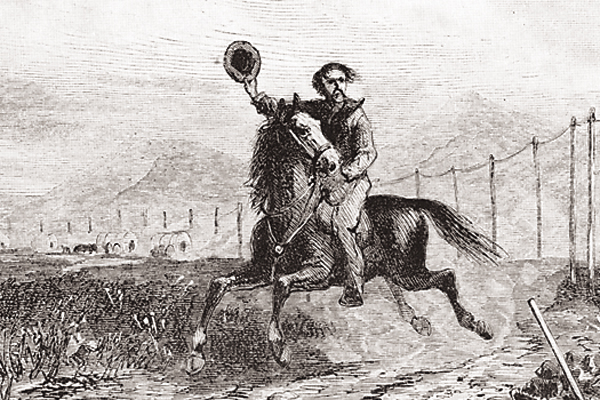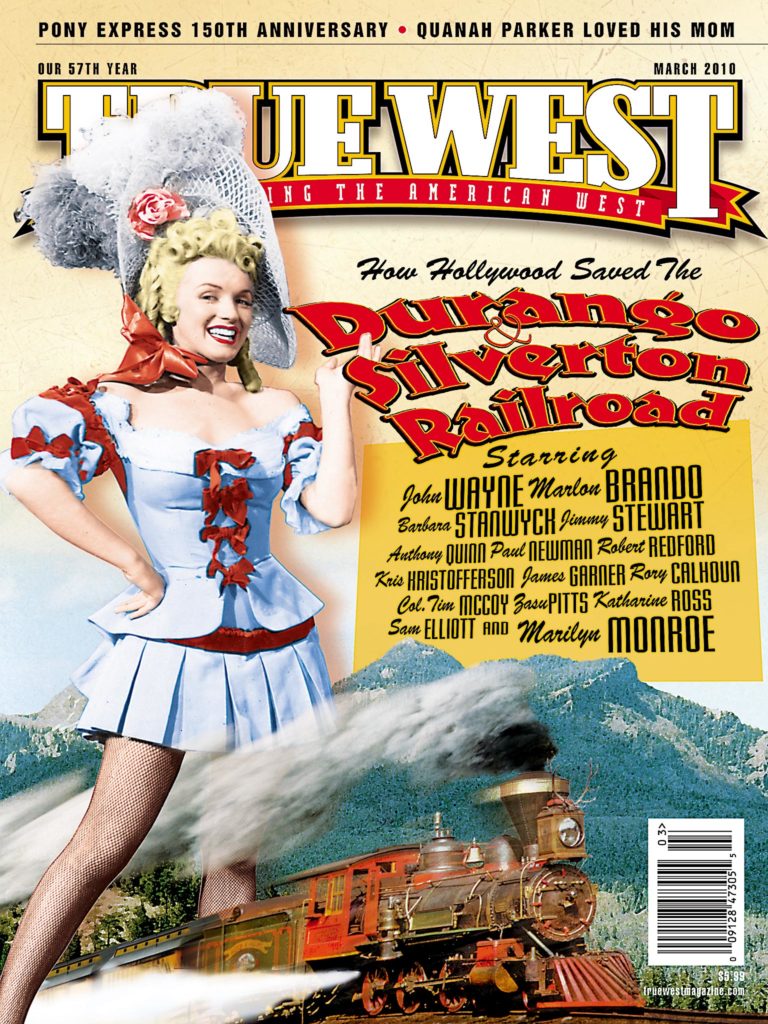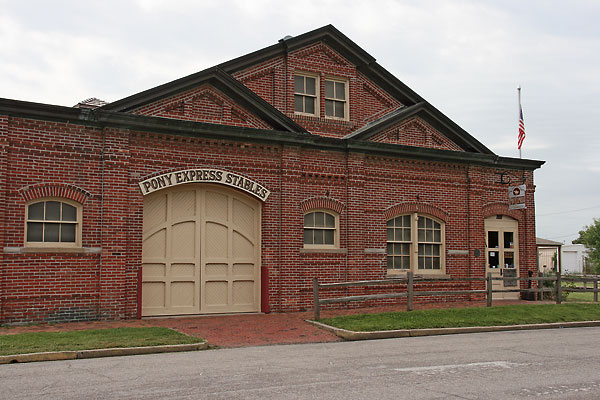
The Pony began when Johnny Fry rode from Pikes Peak Stables in St. Joseph, Missouri on April 3, 1860.
Its lifespan was short, a mere 18 months, but wow, has it become an important story—an icon—of the American West. We guess that’s because it involved tough young men who found adventure and excitement during a pivotal period in the nation’s history—that unsettled time just before the Civil War.
William H. Russell, William B. Waddell and Alexander Majors founded the Pony Express in response to the need for faster communication between Eastern and Western areas of the country as the threat of Civil War escalated. From the get-go, it was a two-way service, so when Fry set off with the mochila from St. Jo, another rider also departed from Sacramento, California, the western terminus of the 2,000-mile overland trail, riding east.
During the 150th anniversary of the Pony, who better to send down the mochila trail than our Renegade Roaders Johnny D. Boggs and Candy Moulton. How did they keep track of each other? Via mail, of course!
ST. JOSEPH, MISSOURI
Dear Johnny,
I just checked—the horses are in the stables, the mochila is packed with maps, guides and mail, and it’s almost time for the first rider of the Pony Express Sesquicentennial to head out on the trail. What say, you and I make our own relay across the route?
Naturally, the Pony Express Museum and Patee Park will host the first events on April 1-3, which include a Buffalo Bill Cody look-alike contest and a concert by Michael Martin Murphey.
The cool thing about the Pony Express Museum is that it is on the site of the original stables. When you take the tour the guides point out a water well and an excavation that shows some of the original stable construction.
Each year members of the National Pony Express Association (NPEA) carry mail across the route by relay riding, just as the original Pony boys did. Although the reride generally takes place in June, that does not mean it is easy. The riders have found themselves in snowstorms in Wyoming in the middle of the night. In 2009, they rode through mud and rain in Nebraska, proving that even today the mail transfer business is demanding physically.
For this year’s reride, all of the riding will take place during daylight hours from June 6-26 as the relays travel the entire distance from San Francisco, California, to St. Joseph, Missouri. This plan will allow communities across the route to hold events coinciding with the mail run. Since mail deliveries in 1860-61 were made on both eastbound and westbound runs, the reride also alternates; this year’s reride will begin in the west and travel to St. Jo where the culminating event takes place on June 26. The city will celebrate with a river crossing and a parade, with riders passing the Pony Express monument and ending at the Patee House Museum.
Now I’m sure you realize one rider couldn’t cover that entire distance on the same horse. In order to provide the quick service desired, the mail carriers worked in relays. The riders averaged about 10 miles per hour, with the first westbound trip made in nine days and 23 hours, and the eastbound journey in 11 days and 12 hours. (I’ve never quite figured that out, since the wind would be at your back from the west.) To provide a place to change horses, or get a meal, the riders used a series of stations set roughly 20 miles apart. Those used for a quick change of horse were relay stations, while the home stations served as places for the riders to actually live between their runs. As you head west into Kansas, you’ll find evidence of these stations, so I’m handing off on the first relay.
Your Pal,
Candy
KANSAS
Dear Candy:
Having insulted various locals about what passes for Mexican food in this state, I must beat a hasty retreat across these amber fields of grain. But not without stopping, just across the Missouri River, in Atchison.
It’s only fitting that Atchison was on the Pony Express Trail. This city has always been a transportation hub. After all, it’s the first city mentioned in the Atchison, Topeka and Santa Fe Railroad. It’s the birthplace of Amelia Earhart, and even Lewis and Clark camped here on July 4, 1804. A good place to bone up on local history is the Atchison County Historical Society Museum, located in the 1880s Santa Fe Depot. And, no, Atchison isn’t forgetting its place on the Pony Express Trail. On June 25, mail will be relayed into town from Kennekuk, the way it was delivered during the last two months of the Pony’s operation.
Just up U.S. 73 is another transportation town Horton, which the Pony galloped through before the Rock Island Railroad town even existed. Horton wasn’t founded until 1886, but that won’t stop the city from celebrating the Pony’s legacy at noon on June 22.
The first home station west of St. Jo was in Seneca, on U.S. 36, and it’s a good place to climb out of the saddle. The home station, the Smith Hotel, is long gone, but the Pony Express Museum across the street at Fourth and Main features a saloon, blacksmith shop, stables and many relics from the hotel. While you’re in town, check out the Fire Station Museum—and, specifically, that restored 1922 Stutz fire engine—a couple blocks from the Pony, but keep in mind tours are by appointment only. Then hit the road to the cream of Kansas’s Pony stops.
Marysville is home to the only Pony Express home station still standing on its original site, the Pony Express Original Home Station No. 1, Barn & Museum. Built in 1859, this limestone building now includes an annex, which was dedicated in 1991, that tells the story of the Pony.
The last stop in Kansas is in Hanover, where the original Hollenberg Station still stands. Built in 1857 by Gerat and Sophia Hollenberg as a way station for Oregon and California Trail trekkers, it also served the Pony as a relay station. A visitor’s center provides a grand overview of life on the trails and with the Hollenbergs.
From here, I can see the Nebraska state line, so I’m handing you the mochila.
Your obt. servant,
Johnny
NEBRASKA
Dear Johnny,
When my kids were about as big as your Jack is now, I traveled all across Nebraska conducting research for one of my books. This is a long state, and the way we got across it was by popping a Mike Blakely CD in the car player and putting the gas pedal down. (Don’t tell Mike, but my kids still remember those long drives and threaten me if they get in the car and I have one of his CDs playing.) Anyway, Nebraska has lots of trail miles—those of the Oregon, California, Mormon and, of course, the Pony Express. As I ride north out of Kansas, my first stop on the trail is at Rock Creek Station, off Highway 8 just south of Fairbury, with its trail ruts made by wagons beginning in the 1840s. Pony Express events here on June 21 take place at 3:45 p.m. when the mail is slated to arrive. Will it be on time?
From Rock Creek I’m off to Fort Kearny, one of the critical provisioning points on the overland trails in the 19th century as well as a station for the Pony. On June 20 an old-fashioned picnic with costumed interpreters will begin at 1 p.m. and continue until 5 p.m. when the Pony rider arrives with the mail. Earlier in the day mail events will be held in Cozad at Willow Island Station at 10 a.m. and, even earlier, at 8 a.m., at the Machette Pony Express Station in Gothenburg’s city park.
Besides Fort Kearny State Historic Site, visit the Platte River Archway in Kearney, an interpretive center that literally spans I-80. While the big events for the reride are in June, a visit to this North Platte River stretch anytime in March or April will be a treat as “Crane Watch” takes place. Thousands of sandhill cranes stopover here as they fly from their southern ranges to summer nesting grounds in Canada and the Northwest Territories. This has to be one of the greatest concentrations of waterfowl in the country, and it is really one of those experiences to put on your “1,000 Things To Do in My Lifetime” list. Since this is a historic migratory route for the birds, I’m betting the 1860s Pony riders saw cranes here when they were running the mail a century and a half ago.
Heading west from Kearney, take U.S. Highway 30 through Gothenburg with its original Pony station located in the city park, continue through North Platte (home of Bill Cody’s Scouts Rest Ranch) and head on to Ogallala, best known for its cowboy and cattle trail roots. South of the town, Ogallala Trails Park will hold events on June 19 as the Pony arrives.
From here the Pony trail angles along the South Platte River to Julesburg, Colorado, before swinging back north into Nebraska to travel past Chimney Rock State Historic Site and Museum at Bayard. Continue on to the Scottsbluff-Gering area and visit Scotts Bluff National Monument, the Platte Valley Museum and the Farm and Ranch Museum with its displays of antique farm equipment ranging from horse-drawn implements to steam engines.
Handing off,
Candy
COLORADO
Dear Candy:
Colorado’s my kind of Pony Express state. It’s short. Really short. Like, here I am in Julesburg, home of Jack Slade, the “most bloody, the most dangerous and the most valuable citizen that inhabited the savage fastnesses of the mountains.” Or so says Mark Twain, and who am I to argue with Sam Clemens?
Actually, Julesburg is the home of a massive welcome center on I-76, where stands Brenda Jean Daniher’s bronze salute to the riders, God Speed to the Boy and the Pony. Julesburg, founded at the Upper California Crossing on the South Platte River, was first called “Jules’s Ranch” after trapper-trader-rancher Jules Reni, then “California Crossing” before finally earning its current handle.
You can check out how wicked the town was at the Fort Sedgwick Depot Museum and the Fort Sedgwick Museum. I’m not sure how wild things will get at a barbecue and music festival scheduled for the eve of June 19, but at least Slade won’t be gunning down any dancers.
I’m done. Told you this was a quick trip.
Yours truly,
Johnny
P.S. This Slade character interests me. While you’re traipsing across Wyoming, I’m heading over to Virginia Dale, another Slade station, northwest of Fort Collins near the Wyoming line. See you at the Utah border.
WYOMING
Dear Johnny,
You slacker! Admittedly the mileage of the XP Trail in Missouri is about equal to that of Colorado, but heavens to Betsy, Nebraska is nearly three times the length of trail you wrote about in Kansas. Now here I am in Wyoming … another major trail state. But it’s home for me, so thanks for giving me this leg of the relay.
By the way, in the days of the Pony, much of Wyoming was actually Nebraska or Utah Territories. These days folks like me who were born in Wyoming have off-color jokes about both those states.
But, since I think we can agree we need to hook Jack and other kids on history, I won’t share those tales here. The first major point that’s a good kid place in Wyoming is Fort Laramie, which is arguably the most important historic site in the state. I say that because it was pivotal in four of the major historical eras: fur trade, Indian relations/wars, overland trails and frontier military. The fort offers a living history program over the Fourth of July and another in August.
The Pony boys loped their horses west along a route now basically along U.S. 26 and I-25. Since I know you are always on the lookout for a good hamburger, I recommend a detour. At Guernsey, take the side trip three miles north to Hartville, home of the Miners and Stockman Bar, and the best burger I’ve had in many a year on the road. If you ride through Douglas in mid-August, take in the Wyoming State Fair.
Casper did not exist during the days of the Pony, although there was a bridge across the Platte River, giving the area—and the Pony Express Station—the name Platte Bridge. Fort Caspar (named for Lt. Caspar Collins, who was killed in a fight with Northern Plains tribesmen in July of 1865) is the successor to Platte Bridge Station. The fort plans on presenting Pony Express programs and exhibits this summer. Head up the hill from the fort to the National Historic Trails Interpretive Center, where you’ll see a mochila used in modern-day rerides by the NPEA. It has signatures on it of the men and women who keep this tradition alive today.
At the trail center, you and Jack should take your own ride across the prairie by climbing into the stagecoach for a virtual trip between two stations. On the eve of June 16, you both can watch the relay rider arrive with the mail.
Instead of following Highway 220 west out of Casper to Independence Rock, stick to the trail itself by driving west on Zero Road and then Natrona County Road 319 (also called Oregon Trail Road). You can pick up a map at Fort Caspar or the Trails Center. This route puts you on the track of the Pony (and the other main emigrant trails) and past the sites of the Willow Springs and Horse Creek Stations.
For the Pony, the area near Independence Rock became Sweetwater Station, while less than 10 miles west was Devils Gate. Be sure to climb the east face of Independence Rock for one of the greatest views in the West. Looking east you’ll see the Sweetwater River and the largely undeveloped land and ruts of the emigrant trails. To the west you can see the south end of the Rattlesnake Mountains and Devils Gate, plus the Sweetwater River. If you are here during the afternoon of June 16, you might see the Pony rider heading east.
I strongly encourage you to take in this view soon as it could change forever before long. All across Wyoming plans are underway to develop wind power projects; one is proposed on private land east of Independence Rock. If it goes in, I can almost guarantee the open space feeling and view you now have from the top of Independence Rock will change.
Enough of my soapbox, head on west following the Sweetwater River until you reach South Pass on Highway 28, which will take you through Farson to the Green River and southwest to Granger, where a mail event takes place at Hams Fork Station on June 15 at 1:15 p.m. Drive to Fort Bridger for a visit to the re-created Bridger trading post and the military-era buildings. From here it’s a short hop on over to Utah.
Still yer Pal,
Candy
UTAH
Dear Candy:
I know why the Pony came through Utah. It wasn’t for those spectacular desert vistas at Simpson Springs Station down in Tooele County. It had to be for the hamburgers.
Those Crown Burgers in Salt Lake City— whoever thought up that pastrami cheeseburger deserves a Nobel Prize—and the wonderful variety of burgers (washed down by delicious milkshakes) at the Burger Bar in Roy are enough to make a Pony Express horse cringe at carrying all that extra weight the riders just put on.
But I digress. Utah’s big day for the Pony is June 14. That morning, a presentation at Camp Floyd/Stagecoach Inn will take place in Fairfield.
Camp Floyd, the first military installation built in present-day Utah (1858), helped keep the Pony riding during troubles with the Indians. While the adobe building that served as the Pony station is long gone, the two-story Stagecoach Inn, built by John Carson in 1858, served as the first stop south of Salt Lake City on the Overland Stage route. Restored in the summer of 1959, the frame building looks like a comfortable spot to take a siesta.
But not on June 14. Because later that morning, they’ll be dedicating a new Pony Express monument over at Eagle Mountain. That evening the fun continues at This is the Place Heritage Park, a 450-acre living history museum in Salt Lake City—complete with more than 40 original or replica buildings—which examines life in Utah from the Mormon arrival in 1847 to statehood in 1896.
To see real Pony country, take the Bureau of Land Management’s Backcountry Byway from Fairfield to Faust, Lookout Summit, Simpson Springs (complete with a campground and reconstructed station), Fish Springs and through the Snake Valley to Callao and on over to Ibapah—133 miles, most of it gravel and dirt, marked by monuments to or ruins of 14 Pony station sites. The Byway is open year-round, but four-wheel drive vehicles with chains, tow rope or winch are a must after heavy precipitation. Wonder what the Pony riders would think of that.
Worn out,
Johnny
NEVADA
Dear Johnny,
Wow, I got a little windy in Wyoming … guess it’s just natural in that state.
Here I am in Nevada. The traditions of the buckaroo and cowboy are still maintained at the National Cowboy Gathering and Folklife Center in Elko, which of course hosts the granddaddy of gatherings every January. While in Elko also check out the Northeastern Nevada Museum with its outstanding display of Will James art and the Ruby Valley Pony Express Station, which has been moved to the site from its original location. The adjacent Sherman Station is a good place to pick up information about the Pony trail. A new California Trail Interpretive Center is in place just west of town. It is not yet fully operational, although it has some exhibits with others being planned.
From Elko follow the Pony trail south through Jiggs, on through Diamond Valley and end up at Fort Churchill, which was constructed beginning July 20, 1860. This outpost guarded the Pony Express route and other mail routes. The fort was in place only until 1869, but the site is now a Nevada State Historic Park. Nearby Buckland Station, a half mile south of Fort Churchill, served the Pony Express and also the Overland Stage Road.
Stay on Highway 50 through Carson City to Genoa, the first permanent settlement in the valley, founded in 1851 by Mormon traders. South of Genoa, take Foothill Road past the Van Sickle Station, location of a large hotel built by Henry Van Sickle in 1857 and which served as a trading post, freight station, Pony Express station and stagecoach stop. Several of the original buildings remain standing.
For the sesquicentennial, reride events are planned June 8 in Genoa (6:30 p.m.), June 9 in Carson City (8 a.m.) and Fort Churchill (2 p.m.), and June 12 in Schellbourne (mid-morning).
Exhausted myself,
Candy
CALIFORNIA
Dear Candy:
I know why you wanted me to take California on this Renegade Roads trip. (Readers: Candy doesn’t drive through cities, and Sacramento is a big city.) But once you get to Old Sacramento, you can park your car, kid, and step back into time at this 28-acre site of historic buildings.
Here, the Pony ended its ride on horseback. Oh, sure, the mail would be carried on down the Sacramento River to San Francisco, but by ferry, not pony. In fact, on June 6, the mail will come up the river by ferry to Old Sacramento, expected to arrive at 8 p.m., and the next morning, a rider will take off at 11 a.m., and the Pony Express will live again.
Then again, the Pony is always alive in Old Sacramento.
The Western terminus was at 2nd & J Streets at the B.F. Hastings Building, now a small but informative Wells Fargo History Museum complete with original gold scales. While walking around Old Sacramento, I’ve also checked out the Sacramento History Museum and the California State Railroad Museum and, naturally, the Pony Express Statue at Pony Express Park on 2nd & J Streets.
Hmmm, one thing I’m not certain about the rider on that statue: Is he coming, or is he going? Oh, well, how about if we meet at the lounge on the Delta King and discuss it over a bottle or two of California pinot noir?
Best,
JDB
Dear Johnny,
I’d meet you except for one thing. I don’t drink whatever pinot noir is … as you darn well know, I drink Jack Daniels. Oh, if I did make it out there, you’d be doing the driving!
Too bad you can’t “wish” the Delta King riverboat to life and have it ferry you to Fisherman’s Wharf, since, as you know, the overland route ended in Sacramento, but the mail delivery continued on to San Francisco. The steamboat Antelope was chosen to carry James Randall’s eastbound mail on April 3 and Billy Hamilton’s westbound mail that arrived on April 13.
By the way, are you trying to butter me up by calling me “kid,” so, if I do make my way out there, I’ll buy that first drink?
Bottom’s up in salute to the Pony!
Candy


